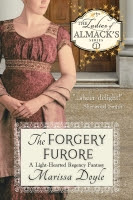
Looks a bit like a bicycle, doesn’t it? But there are no pedals. The hobby horse, invented in Germany in 1817, was made of iron and wood with a padded seat and sometimes a rest for your chest. The idea was that you straddled the horse and pushed with your heels on either side in a walking motion, setting it to rolling. Then you sat back or laid back and let it roll for a time before pushing it again. The running machine, as the baron called it, could reach speeds up to nine miles an hour on a good road. The baron envisioned them for military as well as civilian use.

A coach builder named Denis Johnson is credited with bringing the fad to England, where it was soon a hit. Johnson refined the design and marketed it to the elite. London dandies embraced the concept to such as extent that some people began to call the device the Dandy Horse. Johnson custom-built each one to the size and shape of its owner and painted it in whatever colored the owner fancied. He even made a version for the ladies, who apparently stood on a lower step and pushed off with one foot only, much like a scooter, then sat sidesaddle to roll. You could even rent them by the day or the hour to get around London. Prints and pamphlets advised on the proper way to ride the vehicles. Mr. Johnson went so far as to open a Pedestrian Hobbyhorse Riding School on the Strand, charging a shilling a lesson.
 Like any young gentleman handed a new toy, the nineteenth century youth were excited to see how far they could take the things. All over Europe, towns held races. Legend has it that a hobbyhorse beat a coach and four from London to Brighton. Hyde Park became overcrowded with packs of the things whizzing along.
Like any young gentleman handed a new toy, the nineteenth century youth were excited to see how far they could take the things. All over Europe, towns held races. Legend has it that a hobbyhorse beat a coach and four from London to Brighton. Hyde Park became overcrowded with packs of the things whizzing along.Unfortunately, they became such a menace in London that the magistrates had to ban them. By 1840, they had become a quaint memory.
I know a few shopkeepers who wouldn’t mind skateboards meeting the same fate.





5 comments:
I wonder if humans will look back at pictures of us in years to come and laugh at the silly contraptions that we are riding? That just looks so silly riding a bike w/ no pedals LOL...I knew they started that way, I just can't imagine ever riding one.
The Pedestrian Curricle scene in Georgette Heyer's Frederica is one of my favorites. Thanks for the visuals. It looks pretty much like I pictured it from the description.
Ladybrinx, I can actually imagine riding one, but not in long skirts! QNPoohBear, I'll have to go back and look at Frederica. I'd forgotten that scene!
Any idea when the term "hobby horse" started to refer to a child's wooden horse on rockers?
Annebingham, I don't have an exact date, but I'm guessing some time in the Victorian period.
Post a Comment